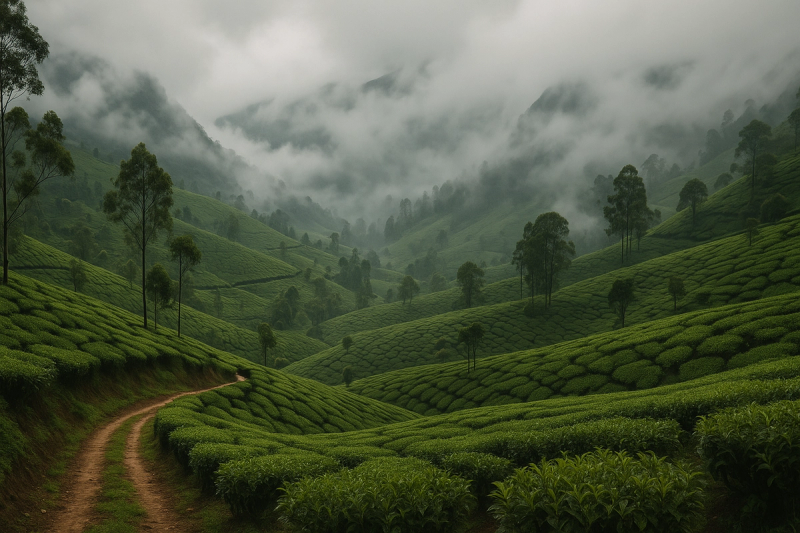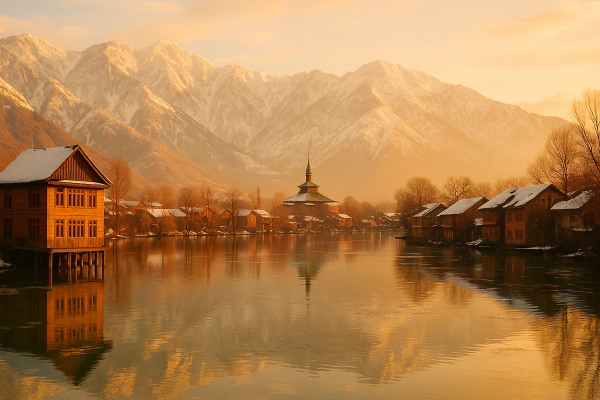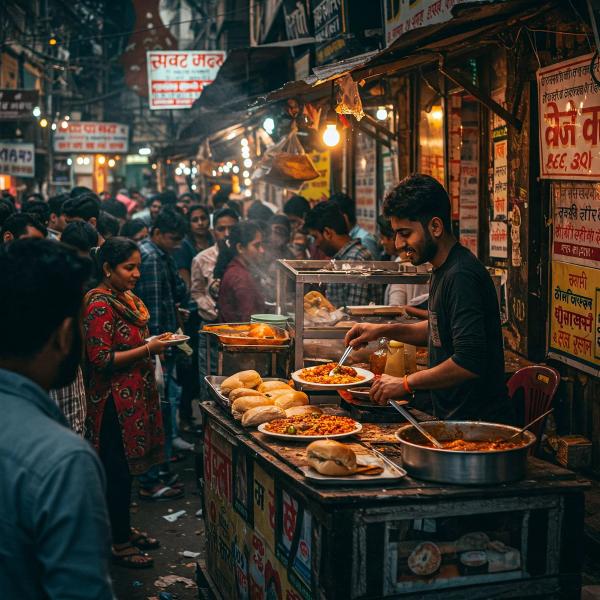Munnar Monsoon Travel Guide: Tea Plantations, Trails & Mist — the real deal, yaar#
So, I finally did the thing I keep telling other people not to do — I planned a hill-station trip smack in the middle of monsoon. And honestly? Munnar turned out to be the right kind of crazy for rain lovers. Those switchback roads from Kochi, the wet green that hurts your eyes in a nice way, and that mist that just rolls in like it owns the place… it feels like someone pressed “soft focus” on reality. I’ve done Ooty, Coorg, the works, but Munnar in rain is different. Smells like wet tea leaves, cardamom, earth. And the sound — rain on tin roofs, distant water crashing through valleys. You know that comfort you get when the chai guy shouts “chaaya, chaaya”? Multiply that by fifty. That’s the vibe.¶
Why monsoon Munnar hits different (and why I didn’t regret a single soggy sock)#
We Indians love drama. And monsoon in Munnar is pure theatre. The clouds come low and sit on tea gardens like they’re paying rent. Waterfalls turn from polite trickles into full-on flex, and all the tiny streams become busybodies. The tea estate slopes — all that clipped, bright green embroidery — look extra shiny and new after a fat downpour. Also, fewer crowds compared to the classic December rush, and stays are slightly cheaper if you book smart. The catch? You gotta be flexible. Plans shift because a landslide might close a road, or fog swallows a viewpoint. But the softer things open up: slower walks, hot chai breaks, long talks with chetta at the bakery, and that insane photo you click when the mist parts for ten seconds and you’re like… wow, this is it.¶
Getting there in the rains — buses, cars, and the one road everyone loves to hate#
Most folks come up from Kochi. Nearest airport is Cochin International, then you have the drive via NH85 (the old Kochi–Munnar stretch), about 4.5–5.5 hours depending on rain and your driver’s patience levels. KSRTC runs regular buses from Ernakulam and Aluva — cheap, comfortable enough, and frankly more sensible if you don’t wanna white-knuckle the steering in fog. Taxi rates from the airport sit roughly around ₹4,500–₹6,500 one way, depending on vehicle and bargaining mood. Self-drive? Just go slow. Hairpins plus rain plus fog equals not a race. Keep an eye on Kerala State Disaster Management Authority (KSDMA) updates during heavy spells — they put out orange/red alerts that matter. As of 2025, locals in Idukki still advise avoiding night drives in peak rain because, well, elephants, fog, and surprise road works… none of that cares about your itinerary.¶
Where to stay — tea estate rooms, homestays, and the ‘rain view’ you didn’t know you needed#
Munnar town is the busy hub, but a lot of the charm lives in places like Chithirapuram, Devikulam, Pallivasal, Suryanelli, and Lockhart Gap area. Homestays start around ₹900–₹1,500 per night for clean, simple rooms. Decent mid-range hotels and boutique stays go ₹2,500–₹5,500. Plantation resorts and tea bungalows? ₹7,000–₹15,000+, especially if they throw in estate walks, campfires, and views that slap. Treehouses have become a thing (Instagram made them famous), but book with properties that have proper rain-proofing and backup power. In monsoon, I’d pick a place slightly away from the town noise but not too far from the main road — convenient for quick runs to food and fuel. Flexi cancellation saved my skin once because a landslide near Top Station messed up one day’s plan. Pro tip: always confirm the room has a proper geyser and a dryer space for wet clothes. And ask them about leech management around the garden — real talk.¶
My stay — the auntie who kept refilling my glass and the generator that hummed like an old friend#
I landed up in a homestay near Devikulam run by this sweet auntie who said “chaaya?” before I could even say namaskaram. Her house sat above a small tea slope, rain thudded on the tiles, and the balcony had those plastic chairs with stubborn water beads on them. First evening, power went, generator kicked in like a shy child, and we sat with dim lights eating hot puttu and kadala curry while she told me which waterfall was “photo-photogenic” and which one “simply wet.” That night I slept under a thick blanket with that Munnar cold creeping into your bones in a nice way. Morning, fog everywhere. She packed me banana fritters and warned me about leeches on the trail — “Don’t fear, put salt.” Chechi knows exactly what she’s talking about. I loved staying away from the main market, less honking, more extra rain sound.¶
Tea plantations: how to explore without being that person who tramples bushes and annoys workers#
Munnar’s tea estates are living factories. Folks are working, weighing, hauling, plucking — so walk respectfully. Most gardens are private. Ask your stay if they have estate access or a guided walk. KDHP Tea Museum in Nallathanni Estate is the easy intro — old machines, stories about planters, and a tasting room. Timing usually 9 am to late afternoon, closed some holidays, entry fee in the few hundred rupees range. Kolukkumalai (technically Theni district, Tamil Nadu side) is the high-altitude superstar for sunrise views. Monsoon mornings might be misted out, so don’t fixate on sunrise — go for the estate drive, chai, and the views when clouds part. Jeeps from Suryanelli do the route, rates around ₹2,000–₹3,000 per vehicle depending on mood and weather. Drones are a strict no near estates and the national park. Trust me, that one viral video isn’t worth annoying forest staff.¶
Trails, permits, leeches: Meesapulimala, Eravikulam, Lakshmi Hills, and the viewpoints that vanish and return#
Meesapulimala trek is managed by Kerala Forest Development Corporation (KFDC). Book in advance on their portal or at the Munnar office. Options include base camp stays, Rhodo Valley camping, guided treks. Prices move around ₹1,500–₹4,000 per person depending on package. Eravikulam National Park is the other big one — home of the Nilgiri Tahr and those rolling shola-grassland views. They run a shuttle from the entrance after you buy tickets, often available online to prevent crowd chaos. The park closes annually for Tahr calving (usually around Feb–Mar), so check dates. Monsoon time, paths get slick, waterfalls like Lakkam near Marayoor pump up nicely, and Pothamedu/Lakshmi Hills viewpoints play hide and seek with fog. Best way? Start early, go with a local guide if the trail is less known, and carry spirit to accept that sometimes the mountain just says “not today.” Leeches are around — wear leech socks or tight long socks, dab Dettol on shoes, and don’t panic if one finds you. Salt works. They don’t love you, they love your blood, ok.¶
Food & chai — the real fuel of a rainy day#
I’m a shameless chaaya addict, and Munnar delivers. Tea shops everywhere, hot cups for ₹20–₹50 depending on how touristy the area is. Breakfast heroes: appam with veg stew, puttu-kadala, idiyappam with egg roast, parotta with beef or chicken curry if you eat non-veg, and like fifty different fritters — banana (ethakka), onion (ulli vada), and pazhampori that tastes better when clouds sit in your lap. Lunch? Kerala meals — rice, sambar, thoran, a spicy fish curry if you’re lucky. There are small kallu shaaps (toddy shops) around the outskirts, where they do mean fish fry and tapioca. Prices in Munnar town are slightly marked up, but you’ll still find decent thali for ₹120–₹250, biryani for ₹180–₹300, chai any time. Bakeries are solid — try coconut buns and plum cake. Carry snacks if you’re trekking because estate shops may be far. And hydrate, even when you don’t feel thirsty in the cool mist.¶
Monsoon safety and real updates — don’t wing it when there’s a red alert#
Heavy rain in Idukki means landslides can happen suddenly, water levels rise fast, and visibility goes from meh to zero. Follow KSDMA alerts. If there’s an orange/red alert, avoid risky drives to Top Station, Rajamala, and narrow roads near Attukal waterfalls. Local police and forest folks are helpful — just ask. Download offline Google Maps. Network coverage behaves like moody weather — Jio was decent around town, Airtel patchy in deep estate valleys, BSNL sometimes surprisingly strong. UPI works in most places now, but keep some cash for small tea shops and jeep drivers. Emergency numbers: 112 for general emergency, local forest office contacts posted near park gates. Also carry a basic rain jacket, not just a cute umbrella. Shoes with grip, no slippery soles. Don’t stand near edges for fog photos — ground can be mush. And please, no funny business around wildlife. Elephants don’t do selfies.¶
Side trips & secret corners — when you want to escape the cloud, or chase it harder#
Top Station is famous but unpredictable in the rains — sometimes you get an epic window, sometimes you see your own nose and nothing else. Try Lockhart Gap for that moody valley view. Marayoor (about 40–50 km from Munnar) has sandalwood forests, jaggery-making and sits in a drier rain shadow zone, so it’s a smart alternate plan when Munnar’s too wet. Lakkam Waterfalls on the Marayoor side is gorgeous in monsoon — just don’t go too close when it’s roaring. Kanthalloor’s fruit farms do seasonal produce and the vibe is quietly charming with fewer tourists. Chinnar Wildlife Sanctuary is further out, more scrubby, and sometimes clearer when Munnar is kissed by cloud. Attukal and Nyayamakad waterfalls are close to town and dramatic during rains — respect the barrier ropes, they’re there for a reason. And if someone offers a risky off-road during a red alert, just say thanks and sit tight with hot tea.¶
Budget & when to go, without sugarcoating the rain game#
Daily budgets vary, but here’s a real-world ballpark. Backpacker mode: ₹1,800–₹3,000 per day (budget homestay, KSRTC buses, local eateries, a museum ticket). Mid-range comfort: ₹4,500–₹8,000 (better stay, a taxi for local day trips, proper meals, one guided trek). Splurge in style: ₹10,000–₹20,000+ if you’re doing plantation villas, private jeeps, and curated experiences. Best months? For mist and drama — June to September is prime monsoon. October–November brings a gentler second spell, nice for fewer slides. December to February is crisp and clearer, classic tourist season. March–May is warmer, but still green at higher altitudes. Eravikulam often closes for Tahr calving around Feb–Mar; check before you go. Neelakurinji flower? It blooms every 12 years — last big bloom was 2018, next is expected around 2030, so not this season. By 2025, online ticketing for parks and treks is pretty standard — helps manage crowds and saves you standing in rain queues.¶
What I’d do differently if I go again in peak rain#
I got greedy with sunrises when the forecast clearly said “cloud party.” Next time I’ll book Kolukkumalai jeep only on a day with a decent break in showers, even if it means deciding last minute. I’ll carry proper leech socks instead of relying on tight gym socks — they worked, but not great when we hit a marshy section. I’d pair Munnar with Thekkady or Marayoor so I can switch between wet hills and slightly drier plains depending on KSDMA alerts. Also I won’t do long night drives. Even with fog lights, the mix of animal movement and random road repair is too stressful. And I’m gonna spend one half-day just sitting at a tea stall with the camera in bag and phone off. Because in monsoon, the most beautiful photo is often the one your eyes take and your brain keeps.¶
Culture & people — tiny moments that made the trip feel really local#
Munnar’s rhythm isn’t loud. It’s workers moving in raincoats, scales clinking, truck engines coughing awake, and tea shop chatter. Malayalam feels soft here, Tamil mixes in more on the Tamil Nadu border side, and everyone knows the weather better than any app. Say chetta or chechi — it lands nicely. A tea worker once joked with me, “Mist is our guest, sometimes overstays.” Another guy at a bakery told me to try the fresh plum cake they got from Kottayam, and sent me off with an extra piece for the trail — “Vellam aayi, eat slow.” The homestay auntie taught me to eat hot uppumavu on a cold wet evening, no fuss, lots of ghee. It’s not a place where you party hard. It’s where you slow down, walk more carefully, and accept help when someone says, “Road ahead not good today.” That humility feels very Kerala, very mountain.¶
Final thoughts — go for the mist, stay for the chai, leave room for surprise#
If you’re the kind who wants guaranteed views and fixed plans, monsoon Munnar will test you. If you like quiet, green overdose, and soft weather that asks you to listen — you’ll love it. Pick a stay with heart, check alerts, walk kindly through the tea, sip chaaya like it’s medicine, and let your day flex a little when clouds say no. I didn’t tick every box. Couldn’t. But I got something better — a feeling that the hills had time for me even when they hid. Pack patience and the good socks. And if you want more India travel stories and straight-up practical tips, I keep bookmarking pieces on AllBlogs.in — helps when you’re planning from the couch and the rain is already calling your name.¶














